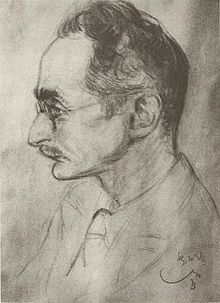
Paul Maas (18 November 1880, in Frankfurt am Main – 15 July 1964, in Oxford) was a German scholar who, among other things, developed principles of textual criticism inherited from Karl Lachmann.[1][2]
He studied classical philology at the universities of Berlin and Munich, receiving his doctorate in 1903. In 1910 he obtained his habilitation and in 1920 became a full professor at Berlin. In 1930 he was appointed chair of classical philology at the University of Königsberg. In 1934 he was forced into retirement by the Nazi government due to his Jewish ancestry, and in 1939 he emigrated to Great Britain, where he taught classes at Oxford University.[3][4] After his death, he was buried at Wolvercote Cemetery's Jewish section in Oxford.
His research interests lied mainly in textual criticism of Greek literature, poetry in particular.
Unlike most of his colleagues, he produced a relatively small number of critical editions: of a collection of Byzantine liturgical poetry (1910); of Apollonius Dyscolus' treatise "On pronouns" (1911); and of Romanos the Melodist's poetry, with Greek scholar C. A. Trypanis (1963, 1970).
He also wrote extensively on Nonnus of Panopolis, although most of his conjectures and observations he never published and only wrote on the margins of the editions by Arthur Ludwich and Rudolf Keydell he owned.[5] A similar work he carried on Apollonius of Rhodes,[6] on Athenaeus[7] and on Herodotus.[8] Classical scholar Willy Theiler once observed that Maas's printed contributions to classical philology must be multiplied by ten, because most of Maas's reflections and thoughts were not published by him and still are not.[9]
His most famous work is the "Textkritik" (1927), a concise theoretical handbook of textual criticism. It has been translated into many languages.[10] He also wrote a handbook of "Greek metre" (1923) and the handwritten notes for his unpublished "Byzantinische Metrik" have recently been discovered at Copenhagen.
His articles were collected by Wolfgang Buchwald in 1973.[11]
Maas formulated Maas's law, an observation of the layout of bookrolls.